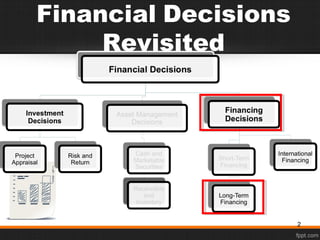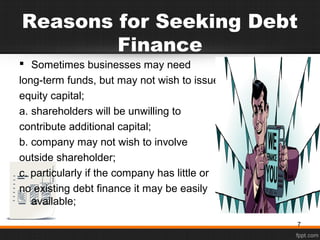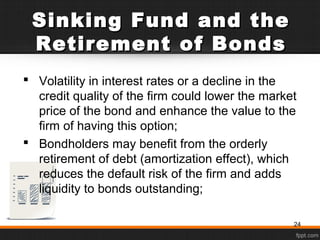Chapter 6.Long -Term Financing-Debt
- 3. Section 1 Sources of Long-Term Financing 3
- 4. The Sources of Long- Term Financing A range of long-term sources of finance are available to businesses including; a.debt finance; b.leasing; c.venture capital; d.and equity finance; 4
- 5. Advantages of Debt Financing The lender is not entitled to interfere borrower’s business decisions. The relationship between two parties is terminated once the debt is settled; Lender can’t claim on business’s future earnings; Business may plan for repayments as they are typically fixed and known; Interest payments are tax deductible which smooth the effect of interest burden; Finally ,it’s more convenient from legal and regulative perspective; 5
- 6. Disadvantages of Debt Financing 6 Debt amount must be repaid in some future time; Payments never take account company’s business cycle or economy’s future conditions as a result company may confront with insolvency risk in rough financial periods; Interest charge is a cash expense and to cover it some money must be withdrawn from business which limits company’s growth opportunities; The company is typically required pledge some assets as collateral or sometimes lenders seek for owner’s personal guarantee;
- 7. Reasons for Seeking Debt Finance Sometimes businesses may need long-term funds, but may not wish to issue equity capital; a. shareholders will be unwilling to contribute additional capital; b. company may not wish to involve outside shareholder; c. particularly if the company has little or no existing debt finance it may be easily available; 7
- 9. Bonds and Their Features Basic Terminology A long-term debt instrument with a final maturity generally being 10 years or more; a. par value- amount to be paid the lender at the end of maturity(it’s usually $1000); b. coupon rate- a stated rate of interest on a bond.Calculated by dividing coupon payment by par value; c. maturity-bond always have a stated maturity when the company is obligated to pay bondholder the par value;. d. current yield-the amount of return an investor will realize on a bond.Calculated by dividing amount of interest by market value; e. 9
- 10. Trustee and IndentureTrustee and Indenture TrusteeTrustee – a person or institution designated by a bond issuer as the official representative of the bondholders. Typically, a bank serves as trustee; IndentureIndenture – the legal agreement, also called the deed of trustdeed of trust, between the corporation issuing bonds and the bondholders, establishing the terms of the bond issue and naming the trustee. 10
- 11. The Risks of Bond Interest Rate Risk Market price of bonds moves inversely to prevailing interest rates in market; When market interest rates rise bond’s value will decrease; When market interest rates decrease then an increase in bond’s price will be inevitable; This situation is relevant only for bondholders who are going to keep instrument until maturity; 11
- 12. The Risks of Bond Interest Rate Risk As a result of fluctuations in market rates value or market price of bond may change; If there is an increase in market rates bond’s value tend to decrease and will be sold at discount(less than par value); On the contrary when market interest rates pursues downward trend then increase in bond price will be expected.This will cause the bond to be traded higher than it’s par value; 12
- 13. Example Interest Rates and Bond Price You purchased a $10 000 bond at par with a coupon yield of 4%.It means that your $400 per year is guaranteed if you keep the bond until the maturity. Now let’s suppose that you’re intending to sell the bond. Two scenarios are possible; a)market rate will rise to 5%; b)market rate decrease to 3 %; 13
- 14. Example Interest Rates and Bond Price a)If market interest rate rises to 5% your bond offering 4% will seem unattractive to investors(%5 compared to %4).To compensate for this you have to decrease the price of bond to an extent until it promises the same yield with the new bonds . Hence, to offer %5 yield for bond with 4% coupon rate and par value of $1000 you have to sell bond at a price of $8000. Bond PriceX5%=$400 Bond Price= $8000 14
- 15. Example Interest Rates and Bond Price b)If market rates fall below coupon rate then on the contrary your product will be a good option for investors(4% compared to 3%) and you will be able to increase the price of bond again up to an extent that 3% yield is preserved. Hence, to offer %3 yield for bond with 4% coupon rate and par value of $1000 you have to sell bond at a price of $13 300 15 Bond PriceX3%= $400 Bond Price= $13 300
- 16. The Risks of Bond Reinvestment Risk- danger that bond investors face is reinvestment risk, which is the risk of having to reinvest proceeds at a lower rate than the funds were previously earning; Call option***** Default Risk-possibility of default must be considered; Inflation Risk-purchasing power will decrease so the real return rate: Liquidity Risk-repayments are never fully guaranteed; 16
- 17. Embedded Bond Options Call option-when interest rates fall until the last day that bond issued then the company will be better of if it calls the existing one back and reissue bond with new prices; Put option-holder entitled to force the issuer to buyback the security. Typically the reason is improved interest rates; 17
- 18. Types of Bonds Zero-coupon bond is bond that makes no periodic interest payments and are sold at a deep discount from face value; Floating-rate notes have a variable coupon,equal to a money market reference rate, like LIBOR or federal funds rate, plus a quoted spread.; • Junk bond-Companies that issue junk bonds typically have less- than-stellar credit ratings, and investors demand these higher yields as compensation for the risk of investing in them; 18
- 19. Types of Bonds(cont.) Convertible bonds include provision of obtaining debt issuing company’s stock in future. Typically lower interest rates are inherent to convertible bonds; • Eurobond-is a bond issued in a currency other than the currency of the country or market in which it is issued; 19
- 20. DebenturesDebentures Investors look to the earning power of the firm as their primary security; Investors receive some protection by the restrictions imposed in the bond indenture, particularly any negative-pledge clausenegative-pledge clause; A negative-pledge clausenegative-pledge clause precludes the corporation from pledging any of its assets (not already pledged) to other creditors; DebentureDebenture – A long-term, unsecured debt instrument. 20
- 21. DebenturesDebentures In this case, subordinated debenture holders rank behind debenture holders but ahead of preferred and common stockholders in the event of liquidation; Frequently, the security is convertible into common stock to lower the yield required by subordinated debenture holders (often less than regular debentures); Subordinated DebentureSubordinated Debenture – A long-term, unsecured debt instrument with a lower claim on assets and income than other classes of debt; known as junior debt. 21
- 22. Retirement of BondsRetirement of Bonds • The corporation makes a cash payment to the trustee, which calls the bond; • The corporation purchases bonds in the open market and delivers them to the trustee; Sinking FundSinking Fund – Fund established to periodically retire a portion of a security issue before maturity. The corporation is required to make periodic sinking-fund payments to a trustee. Two forms for the sinking-fundTwo forms for the sinking-fund retirement of a bondretirement of a bond:: 22
- 23. Sinking Fund and theSinking Fund and the Retirement of BondsRetirement of Bonds When bonds are called for redemption, the bondholders will receive the sinking-fund call pricesinking-fund call price; The bonds are called on a lottery basis (by their serial numbers) and published in periodicals like The Wall Street JournalWall Street Journal; Bonds should be purchased in the open market if the market price is less than the sinking-fund callsinking-fund call priceprice; 23
- 24. Sinking Fund and theSinking Fund and the Retirement of BondsRetirement of Bonds Volatility in interest rates or a decline in the credit quality of the firm could lower the market price of the bond and enhance the value to the firm of having this option; Bondholders may benefit from the orderly retirement of debt (amortization effect), which reduces the default risk of the firm and adds liquidity to bonds outstanding; 24
- 25. Sinking Fund and theSinking Fund and the Retirement of BondsRetirement of Bonds Many bond issues are designed to have a larger final payment to pay off the debt. For example, a corporation may undertake a $10 million, 15-year bond issue. The firm is obligated to make $500,000 sinking-fund payments in the 5th through 14th years. The final balloon payment in the 15th year would be for the remaining $5 million of bonds. Balloon PaymentBalloon Payment – A payment on debt that is much larger than other payments. 25
- 26. Thank You

























